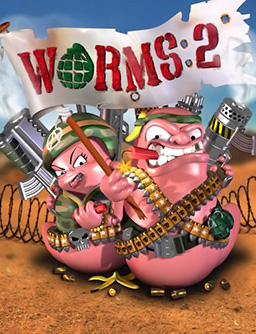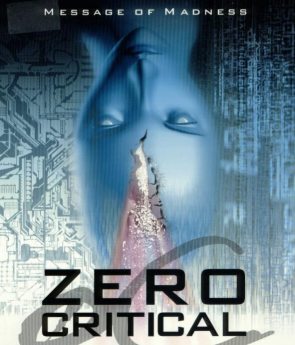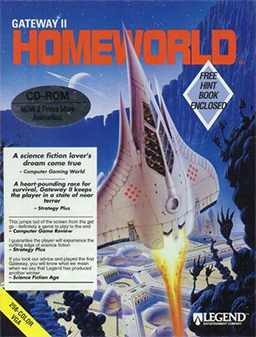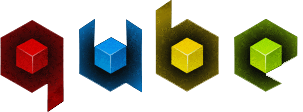
Manhunter: New York is a post-apocalyptic adventure game designed by Barry Murry, Dave Murry and Dee Dee Murry of Evryware and published in 1988 by Sierra On-Line. A sequel, Manhunter 2: San Francisco, was released in 1989.

Frederik Pohl's Gateway is a 1992 interactive fiction video game released by Legend Entertainment, and written by Glen Dahlgren and Mike Verdu. It is based on Frederik Pohl's Heechee universe. It was followed by a sequel Gateway II: Homeworld, in 1993.

Planetfall is a science fiction themed interactive fiction video game written by Steve Meretzky, and published in 1983 as the eighth game from Infocom. The original release was for Apple II, Atari 8-bit computers, TRS-80, and IBM PC compatibles. Atari ST and Commodore 64 versions were released in 1985. A version for CP/M was also released. Planetfall was Meretzky's first published game, and it proved one of his most popular works and a best-seller for Infocom. It was one of five top-selling games to be re-released in Solid Gold versions with in-game hints. Planetfall uses the Z-machine originally developed for Zork and was added as a bonus to the Zork Anthology.

Prey is a first-person shooter video game developed by Human Head Studios, under contract for 3D Realms, and published by 2K Games, while the Xbox 360 version was ported by Venom Games. The game was initially released in North America and Europe on July 11, 2006. Prey uses a heavily modified version of id Tech 4 to use portals and variable gravity to create the environments the player explores.

Rama is a point and click adventure game, developed and published by Sierra On-Line, and released on DOS and Microsoft Windows in 1996; PlayStation version was released in 1998, but exclusively in Japan. The game is based upon Arthur C. Clarke's books Rendezvous with Rama and Rama II, combining elements of their plots with a story that sees the player assuming the role of a replacement crew member for an expedition to investigate an interstellar ship and uncover its mysteries.

Captive is a science fiction role-playing video game released by Mindscape in 1990. In the style of Dungeon Master, it uses pseudo-3D realtime graphics from a first-person perspective. It was released for Amiga, Atari ST, and, in 1992, MS-DOS.

Guilty is a graphical sci-fi adventure game, originally released in 1995 and published by Psygnosis. It is the sequel to Innocent Until Caught.

Marathon is a first-person shooter video game developed and published by Bungie, and released in December 1994 for the Apple Macintosh. The game takes place several centuries into the future in outer space and sets the player as a security officer attempting to stop an alien invasion aboard a colony ship named the Marathon.

Space Quest: Chapter I – The Sarien Encounter is a graphic adventure game, created by Scott Murphy and Mark Crowe, and released in October 1986 by Sierra On-Line. It is the first game in the Space Quest series, and sees players assume the role of a lowly janitor on a research ship, who becomes involved in stopping an alien race using a new form of technology for evil purposes.

Worms 2 is a 1997 artillery tactical game developed and published by Team17 and released for Windows. It is part of the Worms series and a sequel to the 1995 game Worms. As with the first game, players control their team of worms in combat against each other, using a wide collection of rockets, grenades, firearms, explosives, and air strikes, some eclectic and others bizarre. Also as with the first game, the objective is to eliminate all opposing worms and become the sole surviving team.

Mission Critical is a sci-fi adventure game, created by Legend Entertainment for MS-DOS, written by the company's CEO Mike Verdu, and released in November 1995. The game consists of 3D graphics and features live-action scenes, with the cast including Michael Dorn and Patricia Charbonneau. The games storyline focuses on the player taking on the role of a single crew member, who is left behind on their ship after their captain feigns a surrender to ensure a vital mission can continue. The player's goal focuses on repairing their ship after a recent battle, and then getting to the surface of a planet to complete a secret scientific mission that could provide the means to ending a war over technological advancements and artificial life.

Alien Resurrection is a 2000 first-person shooter video game based on the 1997 film of the same name. It was originally intended to coincide with the film's release, but was mired in development hell for several years, finally being completed and released in 2000. The game was developed by Argonaut Games and published by Fox Interactive for the PlayStation.

Zero Critical is an adventure science fiction PC game developed independently by Istvan Pely and published by Bethesda Softworks. It is a 2D third-person game with an emphasis on story and characters. The game was intended as a direct sequel to Majestic (1995) as it concludes the events of that game. Zero Critical is notable for its scientific realism.
Istvan Pely, is an American computer artist and game developer. He works at Bethesda Game Studios, specializing in art direction and 3D graphics.

Samorost 2 is a puzzle point-and-click adventure game developed by Amanita Design. Released for Windows, OS X and Linux on 8 December 2005, the game is the second video game title in the Samorost series and the sequel to Samorost. On 5 November 2020, the game received an update with enhanced visuals, brought fullscreen support & replaced level codes with a level select system. This version also received iOS & Android ports.

Gateway II: Homeworld is a 1993 interactive fiction video game developed and published by Legend Entertainment. The sequel to Gateway (1992), it is set in Frederik Pohl's Heechee universe.

Black Hole Assault is a 1992 fighting video game developed and published by Micronet for the Sega CD. It was released in Japan by Micronet, in North America by Bignet USA as a launch title for the system and in PAL territories by Sega. The game is the sequel to Micronet's Heavy Nova.

Silicon Dreams is a trilogy of interactive fiction games developed by Level 9 Computing during the 1980s. The first game was Snowball, released during 1983, followed a year later by Return to Eden, and then by The Worm in Paradise during 1985. The next year they were vended together as the first, second and last of the Silicon Dreams.

Q.U.B.E. is a physics-based puzzle video game developed and published by Toxic Games, with help from Indie Fund, a group of independent game developers. The game, an expansion of a student project by the founding members of Toxic Games, was released for Microsoft Windows through a number of digital distribution platforms, first through Desura on 17 December 2011 and then through Steam on 6 January 2012. An OS X port was later released in December 2012 through Steam and Desura.
Deponia is a graphic adventure video game developed and published by Daedalic Entertainment. The game's story sees players taking on the role of Rufus, an inhabitant of the junk planet Deponia, as he attempts to seek a new life on the floating city known as Elysium. However, he soon becomes embroiled with the task of helping an Elysian return to their home and uncovers a plot that threatens his home planet.


















